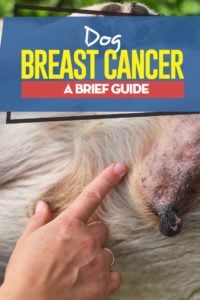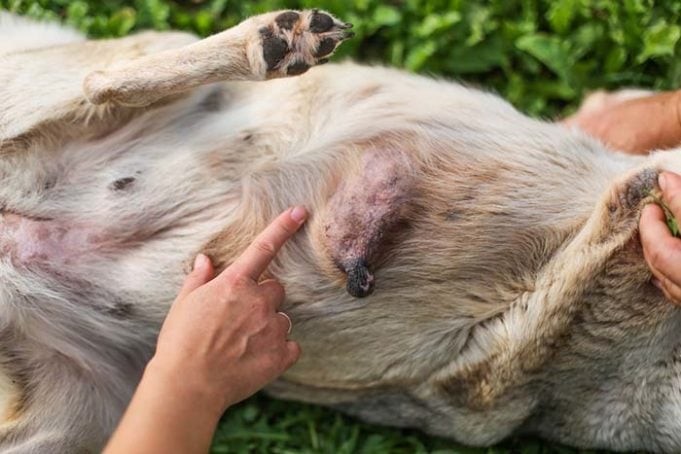Mammary tumors, or breast cancer, is most common in female dogs and is a rare occurrence in male dogs. As female dogs get older, they are more likely to develop breast cancer, while those that are spayed have a reduced risk. Generally, all female dogs are at risk of developing breast cancer, which is a very concerning and intimidating idea for a pet owner.
Since it's possible you may need to deal with this, you should know the signs and symptoms of dog breast cancer to look out for, how to prevent it, and what happens if your pooch does develop mammary tumors. Most treatment is not easy on the dog or you, and it takes weeks to months to treat and care for. There is no quick fix, only long-term preparation and care.
What Is Dog Breast Cancer?
Breast cancer in dogs is usually referred to as mammary tumors. It has been shown to affect almost 1 in 4 unspayed female dogs over two years old. The tumor can develop as either benign or malignant, and is located in the mammary glands.
Mammary glands in dogs are used to produce milk that is needed to feed newborn puppies and are located in two rows along female dog's chest. The nipples show their exact location.
Female dogs are predisposed to have breast cancer along with some breeds being slightly at higher risk statistically, but male dogs can also develop breast cancer. When a male develops this condition, the results are much more dire and less treatable.
Causes Of Breast Cancer in Dogs
What causes the development of cancer in humans and dogs is still not clearly understood by science; it is thought that the development of breast cancer within dogs may have a hormonal component as well as a genetic component.
The hormonal element is presumed due to the reduced risk of dogs who have been spayed versus dogs that have not been spayed. If a dog has been spayed before their first heat cycle, generally at six months of age, the risk of developing breast cancer is reduced to 0.5%. It increases to 8% after their first heat, and 26% after their second heat cycle. 25% of unspayed dogs have a risk of developing breast cancer.
There are certain breeds that are predisposed to canine breast cancer and are more likely to develop it, whether they are spayed or remain unspayed. These dog breeds include:
- Brittany Spaniel
- Dachshunds
- Boston Terrier
- German Shepherd
- Pointer
- English Setter
- Cocker Spaniel
- Poodle
These are not the only breeds that can develop breast cancer, however. All breeds are at risk of mammary tumors. The above are the breeds that studies have shown to be more likely to develop breast cancer versus all others.
Symptoms Of Breast Cancer
Most symptoms of breast cancer are related to the tumor itself and can be felt along the dog’s body, specifically the areas around the mammary glands. These are physical symptoms and are easily identifiable on your dog. Some symptoms include:
- Singular bumps
- Ulcerations
- Yellow nipple discharge
- Pus from the nipple
- Multiple bumps
- Bloody nipple discharge
- Painful breasts
- Swollen breasts
Dogs suffering from breast cancer will not only show physical symptoms but will also experience systemic ones. These are caused by the development of the tumors and change in the body, but cannot be physically touched or felt by the owner.
If the physical symptoms of dog breast cancer go unnoticed, the systemic symptoms should warn you the owner that something is wrong and that there may be an underlying issue for your pet's behavior. Some symptoms include:
- Lameness
- Lethargy
- Loss of appetite
- Breathing difficulties
- Weakness
- Weight loss
Types Of Dog Breast Cancer
There is not a single type of breast cancer that affects dogs. Several different types of cancers can affect canine breasts or mammary glands. Each has its distinguishing features and symptoms.
Sarcoma
Sarcomas are malignant tumors that are made up of bone, cartilage, or fat cells. While they are a type of breast cancer, they are an uncommon cause of breast cancer in canines.
Carcinosarcomas
These are ordinarily malignant tumors in dogs that are made up of epithelial cells, which are cells that are found throughout the animal's body. They are also made up of cells from other tissues.
Adenoma
An adenoma is a benign tumor of glandular origin. Although adenomas are considered to be mostly benign, they can develop into malignant tumors.
Fibroadenoma
These are painless, benign tumors that are created from a combination of skin and connective tissues. These breast tumors have the possibility of being mobile within the breast tissue.
Carcinoma
Carcinomas are malignant growths developed from epithelial cells. They have subtypes such as adenocarcinomas and inflammatory carcinomas that are common causes of canine breast cancer.
Diagnosis of Breast Cancer
When you think you see symptoms of breast cancer in your dog, it is essential to take them to the vet as soon as possible to get a complete diagnosis. Without this diagnosis, veterinarians cannot begin treatment, which can put your pooch at an increased risk of either dying or requiring treatment for the rest of their lives.
When you come to your vet with suspicions of breast cancer, they will usually begin the appointment by feeling the mass or masses on your dog and collecting information about the mass's size, hardness, and mobility. They will ask you to provide your dog's health history, including heat cycles, pregnancies, and medications.
A needle biopsy may be used to determine the type of tumor and may complete the same procedure for the lymph nodes. They will check for other disorders, complete a blood count, urinalysis, and blood chemistry profile. For a final diagnosis and identification, a surgical biopsy may be needed.
Treatment Options
 Dog breast cancer is not something owners can do without visiting a vet clinic. The first step of treating these tumors is the vet having to surgically remove the tumor itself. For most situations, only the tumor and a small area surrounding it will require removal. In other cases, there is a large amount of tissue removed.
Dog breast cancer is not something owners can do without visiting a vet clinic. The first step of treating these tumors is the vet having to surgically remove the tumor itself. For most situations, only the tumor and a small area surrounding it will require removal. In other cases, there is a large amount of tissue removed.
Depending on the tumor, some vets will recommend the removal of all mammary tissue and possibly the lymph nodes not only to clear up current cancer, but to also prevent it from recurring in the future.
It may also be determined that the best course of action is to fight cancer and cancer regrowth with chemotherapy. Your vet may also suggest radiation therapy, but these methods are not as efficient in canines as they are in humans.
READ NEXT: 7 Hidden Toxins in Your House That’re Cancerous to Dogs













